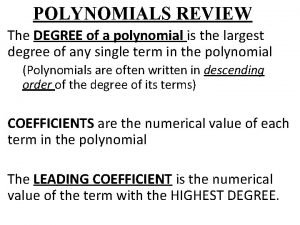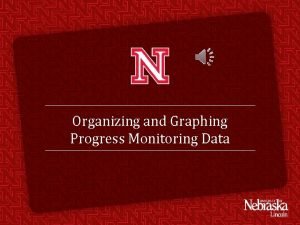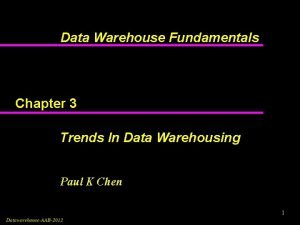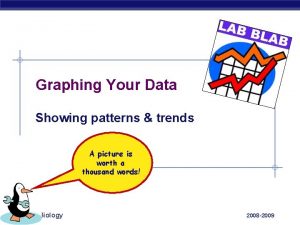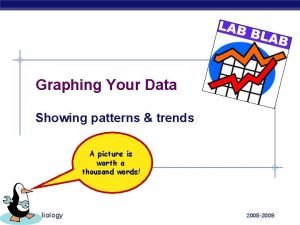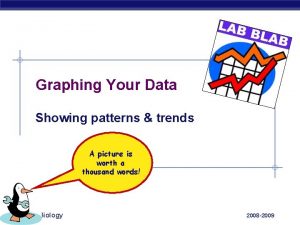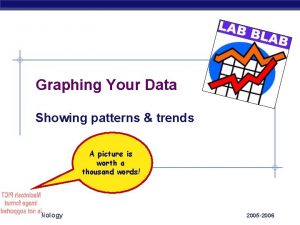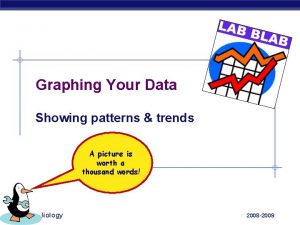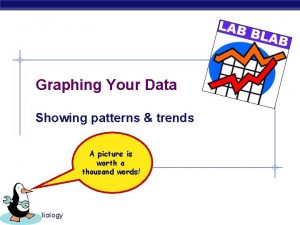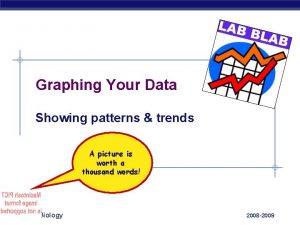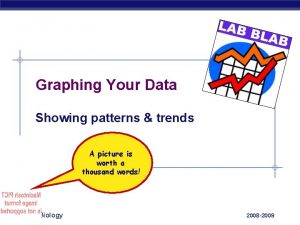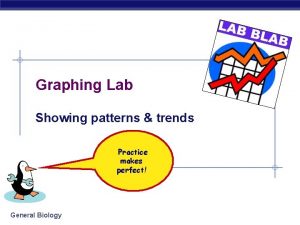Graphing Your Data Showing patterns trends Lets review


















- Slides: 18

Graphing Your Data Showing patterns & trends Let’s review !

What is the purpose of a graph? • A graph is a visual representation of a relationship between two variables, dependent and independent. A picture is worth a thousand words!

Types of data (information) • Variables: *independent variable manipulated variable predictable change: it only changes because we chose how it would change found on the X-axis *dependent variable The effect of INDEPENDENT _______ on DEPENDENT _______ measured variable unpredictable change: we don’t know how it will change until we do the experiment, it’s what you measure in an experiment. found on the Y-axis

Experiment Example # 1 • How does fertilizer affect the growth rate of plants? ▫ we set up an experiment testing different amounts of fertilizer on different plants & measuring the growth (height) of the plants: independent variable (X-axis)? amount of fertilizer dependent variable (Y-axis)? height of plants The effect of Amount of Fertilizer _______ on Height of Plants _______

Experiment Example # 2 • How does exercise affect heart rate of 10 th grade student? ▫ we set up an experiment testing different lengths of time of exercise (minutes) on the heart rate of students: independent variable (X-axis)? minutes of exercise dependent variable (Y-axis)? heart rate The effect of Exercise _______ on Heart Rate _______

Experiment Example # 3 • What’s the favorite drink of students? ▫ we set up an experiment surveying students and asking which is their favorite drink : dependent variable (Y-axis)? number of students independent variable (X-axis)? type of drink The effect of Type of Drink _______ on How many students chose it _______

Which drink do you like best? number of students 6 Bar graph! 5 4 drink number Coke 1 Pepsi 1 Water 4 Iced tea 4 Gatorade 3 3 2 Red Bull? 1 0 Coke Pepsi water type of drink tea Gatorade

8 Making pictures out of data • Graphs ▫ line graphs How’s a critter to choose? graphing data that shows continuous change ▫ bar graphs (or histograms) graphing data that is in disconnected groups

9 How does elevation affect temperature? Line graph! 30 temperature 25 20 18 15 elevation (feet above sea level) temp. (°C) 0 30 500 25 1000 20 1500 15 2000 10 2500 5 10 1200 ft? 5 0 0 500 10001200 1500 elevation 2000 2500

10 Types of Data Relationships Direct – the independent variable increases, so does the dependent. u Indirect (aka. Inverse) - the independent variable increases, the dependent That’s funny, I thought there were more. decreases. u

Types of Data Relationships (cont. ) Cyclic – the independent variable increases, the dependent variable repeatedly increases and decreases. (it shows an up and down pattern) u Static– the independent variable increases, the dependent variable remains the same u That makes sense.

Determining Scale • Two Axis: X (horizontal) and Y (vertical) ▫ Focus on one at a time ▫ Spacing between each number must be of an equal increment ▫ Each line or “box” must have the same value ▫ Majority of grid must be used Check! Is my scale consistent?

Calculating Scale (when the highest value is greater than the # of lines/boxes of an axis) • Count the number of boxes across an axis • Divide the highest data point in the data table by the # of boxes • Rounding up to the nearest whole number Does this always work? Hrs Temp 3 44 6 46 9 43 12 40 • X-axis: • 4 boxes • 12 highest data point • 12/4 = 3 hrs value to each line

Exceptions 1) When the data is not numerical value ie: Dates, Categories…. OR 1. 2) The highest data point is LESS than the # of boxes/lines on an axis-round down Ok! Let’s Practice!

Experiment Example # 4 What would be an appropriate scale for each axis using the below graph paper and data table? Date Snowfall (in) 4/11 4. 3 4/12 3. 2 4/15 12. 6 4/23 21. 8

Experiment Example # 5 What would be an appropriate scale for each axis using the below graph paper and data table? Distance (m) Time (sec) . 5 6 1. 0 8 1. 5 13 2. 0 18 2. 5 24

Experimental Example # 6 What would be an appropriate scale for each axis using the below graph paper and data table? Time Height (cm) 12 12 3 15 6 9

Any Questions? ?
 Graphing periodic trends
Graphing periodic trends Lets review cartoon
Lets review cartoon Integer number definition
Integer number definition Lets review
Lets review Your privilege is showing lillian medville
Your privilege is showing lillian medville A visual aid used to show statistical trends and patterns
A visual aid used to show statistical trends and patterns A visual aid used to show statistical trends and patterns
A visual aid used to show statistical trends and patterns Lets test your knowledge
Lets test your knowledge It observes and checks the progress or quality
It observes and checks the progress or quality Let's check your answers
Let's check your answers Polynomial review
Polynomial review Chapter 9, section 1: labor and wages worksheet answers
Chapter 9, section 1: labor and wages worksheet answers Dating serves several important functions that include
Dating serves several important functions that include Associations and correlations in data mining
Associations and correlations in data mining Give us your hungry your tired your poor
Give us your hungry your tired your poor When graphing cost-volume-profit data on a cvp chart:
When graphing cost-volume-profit data on a cvp chart: How to calculate relative frequency
How to calculate relative frequency Organizing and graphing data
Organizing and graphing data Data warehouse trends
Data warehouse trends










